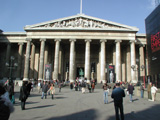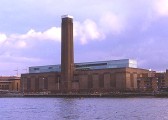ART in Winfield House – The US Ambassador’s Residence in Regent’s Park
Originally published in January 2012 in American In Britain
Imagine what it would be like to live in a home furnished with your favourite contemporary American art. Well, that is exactly what the American Ambassador and his wife, Mr. Louis and Mrs. Marjorie Susman, have done at the US Ambassador’s residence in London. Their residence, Winfield House in Regent’s Park, is one of the grandest mansions in London. Set in twelve and a half acres, it features the second largest private garden in central London after Buckingham Palace.
ART in Winfield House – The US Ambassador’s Residence in Regent’s Park
By Abby Cronin
Imagine what it would be like to live in a home furnished with your favourite contemporary American art. Well, that is exactly what the American Ambassador and his wife, Mr. Louis and Mrs. Marjorie Susman, have done at the US Ambassador’s residence in London. Their residence, Winfield House in Regent’s Park, is one of the grandest mansions in London. Set in twelve and a half acres, it features the second largest private garden in central London after Buckingham Palace.
When Louis Susman was appointed Ambassador in 2009, he and his wife were thrilled to represent the United States in the United Kingdom. Among many things, they felt this was an opportunity to showcase post-war American art, and Mrs. Susman undertook this important task. She wanted to communicate the greatness of American art produced in the last half of the twentieth century. Working with the State Department’s ART in Embassies programme, Mrs. Susman set about consulting with museums directors, gallery owners, art dealers and collectors, to share her vision. They responded with enthusiasm and generosity, and the result is the current exhibition at Winfield House, entitled Americans Abroad: Masterworks by Modern and Contemporary Artists.
Winfield House was formerly owned by the Woolworth heiress, Barbara Hutton, who built this neo-Georgian home in the 1930s. The house suffered extensive damage during the Second World War and after the War Hutton offered the lease on the grounds and house to the United States Government to be used as the official residence for the American Ambassador to the Court of St. James’s. She did so for the princely sum of $1, and President Truman wrote to thank her for this “most generous and patriotic offer”.
Since 1955 Winfield House has served as the private residence for the American Ambassador. Between 1997 and 1999 the house underwent extensive renovation to bring the basic utilities and interiors up-to date. Today it is both a magnificent home and a venue for diplomatic meetings and social occasions. American Presidents, the Queen, the Prime Minister, his Cabinet and many important diplomats enjoy gracious hospitality here.
I had the privilege of meeting with Mrs. Susman at Winfield House on a beautiful bright October day. Sun poured through elegant French windows and enhanced the ornate period furnishings and textiles, especially the glorious Green Room with its stunning 18th century Chinese hand-painted wallpaper. It was a perfect day for a personal tour of the exhibition, and Mrs. Susman’s knowledge of the house, its history and the art is a special story in itself.
In her own words Mrs. Susman told me: *(1) “There is a program called ART in Embassies run by the State Department…the programme helps ambassadors to bring art to whatever country they’re going to and each embassy has a budget. Your interest can help drive the selection….For us, the point was to bring the best art and use it for cultural outreach– the art of diplomacy, if you like. We began by making a wish list. I sat down with a pencil and wrote Mark Rothko, Ellsworth Kelly, Jasper Johns, Brice Marden, Andy Warhol, and so forth. That is how we started..”
“There were certain considerations that had to be taken into account in selecting the art. While it is a private home for the Ambassador and his family, it is also a public place. It serves as a venue for facilitating international diplomacy — so the art must be sensitive to various peoples’ culture and life and not be offensive. It is also a highly decorative home, so we have chosen carefully to ensure that the modern and contemporary American art both challenges and compliments its ornate setting.. ..” So much of the artwork would normally be viewed in a modern white cube gallery; here it is hung alongside intricate draperies and antique furnishings.
“Prior to arriving in post, I had seen the house and we knew we had a limited number of large walls to work with.. The house has wonderful rooms – the Reception Hall with its floor to window ceiling has marvellous light, yet not light which damages the works.” In the Reception Hall there are “two really extraordinary masterpieces by Rothko. They are wonderful, serene works – one in warm ochre/orange…..the other acid green with a more subtle orange. Both were loaned by the National Gallery in Washington DC. These colour-field paintings are as good as it gets. And between them we have hung a minimal, wooden sculpture – Untitled (1987-88) – by the Black American artist, Martin Puryear” (Image: Reception Hall).
“You sense the same contradiction about Claes Oldenberg and Van Bruggen’s Tied Trumpet (2004) (Image pictured) and John Chamberlain’s abstract sculpture Foxymily (2007)” (Image pictured). Tied Trumpet rests comfortably on a giltwood and marble top pier table in the Reception Hall. It seems to greet guests as they enter the home. “Chamberlain works from wrecked cars, metal fenders, and pieces of damaged cars. Then he paints them as you would an abstract painting.” Foxmily is an homage to America’s industrial might and longstanding love-affair with the automobile.*(2) “To me, the collection reflects America’s greatness. This is all post-WWII and that was when American art really came into its own with abstract expressionism, followed by minimalism, pop, and beyond. It’s when America quit painting like Europeans, and began to paint in their own way how they saw the world.”
The State Dining Room, a highly formal room, features two huge chandeliers and six crystal sconces which complement the gold gilded moulding. Here “we placed a Brice Marden, Untitled No.3 (1999-2000), a wonderful layered painting with bold, strong geometric lines. Now it feels like we’ve brought the garden and the room together.
The Main Stairwell is very important and we have Ellsworth Kelly’s Dark Blue Curves, (1997) on the wall going upstairs. He’s one of my favourite artists – he got the key spot. This is one of our own paintings.” The Green Room is decorated with original Chinoiserie 18th century wallpaper. Ambassador Annenberg’s decorator found it in Ireland, had it restored and brought to Winfield House. Above the fireplace, in bold contrast to the leafy trees, birds, butterflies and flowers depicted on the wallpaper, is a bold monochromatic red painting, Abstract Painting Red, (1953) by Ad Reinhardt. (Image in photo of Mrs. Susman and Abby Cronin).
Our time was nearly up and the tour ended when Mrs. Susman escorted me into the magnificent garden. Standing on the lawn outside the back door and facing the house is a remarkable Anish Kapoor sculpture, Untitled (2010), in black granite with three central circles: two concave and one convex. The convex middle circle mirrors the back of the house, but the view is upside down. We moved off to a site nearby where a Louise Bourgeois Spider (1995) resides, looking very contented. The Spider, a well known sculpture, was donated by the artist as a Gift To The Nation. (Image of Spider, Mrs. Susman and students)
Mrs. Susman’s enthusiasm for outreach work extends in many directions. She has given dozens of tours of the exhibition to diverse groups of young people – ranging from sophisticated MA curatorial students from the Courtauld, Sotheby’s and the Royal College of Art, to younger groups of refugee pupils aged 12/13 years. Some groups have travelled from Birmingham and Nottingham. . As Mrs. Susman says, “It’s important to open the doors of Winfield House to a diverse, broader group of people, and art is one way to do it. It’s a part of the many activities that we do. Sometimes they’ve invited me to visit their art works and I’ve gone. It’s a whole way of forming relationships. It’s a different introduction to America.”
*****************************
A final point helps to place the exhibit: Americans Abroad: Masterworks by Modern and Contemporary Artists in Winfield House in perspective. “Established in 1963, the U.S. Department of State’s ART in Embassies Program (AIEP) plays a vital role in our nation’s public diplomacy through a culturally expansive mission of temporary, permanent collections, artist programming, and publications….Now with over 200 venues, AEIP produces temporary exhibitions of original works of art by American artists, on loan from a variety of sources, for the representational spaces of U.S. chief-of-mission residences worldwide.”*(3)
References & Notes
*(1) Mrs. Susman is quoted from a transcript Abby Cronin made from the recording of her tour of ART in Winfield House on 19th October 2011.
*(2) United States Embassy in London: Art in Embassies Catalogue, p. 6
*(3) United States Embassy in London: Art in Embassies Program, p. 1
Images of art in Winfield House: Courtesy of the Foundation for Art and Preservation in Embassies (FAPE) Washington, DC. USA
Image of Mrs. Susman with students studying L. Bourgeois’ ‘Spider’ sculpture, Courtesy US Embassy, London
Contact: Abby Cronin
artsjournalist@abbycronin.co.uk
Website: www.abbycronin.co.uk




